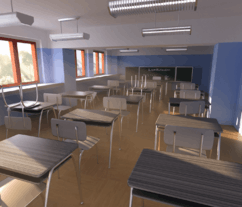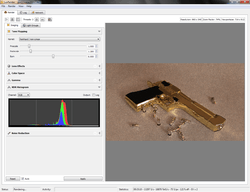LuxRender
 | |
|
A screenshot of Luxrender 0.7 Rendering a Desert Eagle | |
| Developer(s) | Jean-Philippe Grimaldi, Jean-Francois Romang, David Bucciarelli, Ricardo Lipas Augusto, Asbjorn Heid and others.[1] |
|---|---|
| Initial release | June 24, 2008 |
| Stable release | 1.4 [2] / February 6, 2015 |
| Written in | C++ |
| Operating system | Cross-platform |
| Type | 3D computer graphics |
| License | GPLv3 |
| Website |
www |
LuxRender is a free and open source software rendering system for physically correct image synthesis. The program runs on Linux, Mac OS X, and Microsoft Windows.
Overview
LuxRender features only a 3D renderer; it relies on other programs (3D modeling programs) to create the scenes to render, including the models, materials, lights and cameras. This content can then be exported from the application it was created in for rendering using LuxRender. Fully functional exporters are available for Blender, DAZ Studio and Autodesk 3ds Max; partially functional ones for Cinema 4D, Maya, SketchUp and XSI.[3] After opening the exported file, the only thing LuxRender will do is render the scene. You can however tweak various post processing settings from the graphical interface of the program.[4] A significant advantage of LuxRender over other renderers is that the user is able to change the balance of different lights while the image is still being processed.
History
LuxRender is based on PBRT, a physically based ray tracing program.[5] Although very capable and well structured, PBRT focuses on academic use and is not easily usable by digital artists. As PBRT is licensed under the GPL, it was possible to start a new program based on PBRT's source code. With the blessings of the original authors, a small group of programmers took this step in September 2007. The new program was named LuxRender and was to focus on artistic use. Since its initial stage, the program has attracted interest of various programmers around the world.[1]
On 24 June 2008, the first official release was announced.[6] This was the first release that is considered to be usable for the general public.
Features

The main features of LuxRender as of version 0.8 include:[5][7]
- Biased and unbiased rendering: Users can choose between physical accuracy (unbiased) and speed (biased).
- Full spectral rendering: Instead of the RGB colour spectrum, full spectra are used for internal calculations.
- Hierarchical procedural and image based texture system: Procedural and image based textures can be mixed in various ways, making it possible to create complex materials.
- Displacement mapping and subdivision: Based on procedural or image textures, object surfaces can be transformed.
- Network and co-operative rendering: Rendering time can be reduced by combining the processing power of multiple computers. IPv6 is also supported.
- Perspective (including shift lens), orthographic and environment cameras
- HDR output: Render output can be saved in various file formats, including .png, .tga and .exr.
- Instances: Instancing significantly saves system resources, in particular memory consumption by reusing mesh data in duplicated objects.
- Built in post-processing: While rendering, you can add post processed effects like bloom, glare, chromatic aberration and vignetting.
- Motion blur, depth of field and lens effects: True motion blur, both for the camera and individual objects, and physically accurate Lens Effects, including Depth Of Field.
- Light groups: By using light groups, one can output various light situations from a single rendering, or make adjustments to the balance between light sources in real time.
- Tone mapping
- Image denoising
- Fleximage (virtual film): Allows you to pause and continue renders. The current state of the render can be written to a file, so that any system can continue the render at a later moment.
- GPU acceleration for path tracing when sampling one light at a time. [8]
- Film response curves to emulate traditional cameras color response (some curve are for black&white films too).
- Volumetric rendering using Homogeneous volumes by defining an interior, and exterior volume.
- Subsurface Scattering
References
- ↑ http://www.luxrender.net/forum/viewtopic.php?f=12&t=11533
- ↑ http://www.luxrender.net/wiki/Exporter_Status
- ↑ http://www.luxrender.net/wiki/index.php?title=Luxrender_Manual
- ↑ 5.0 5.1 "Features". LuxRender. Retrieved 2008-06-30.
- ↑ "LuxRender 0.5 released". BlenderNation. 2008-06-30. Retrieved 2008-06-30.
- ↑ "LuxRender v0.8 final Release". 5 June 2011. Retrieved 9 June 2011.
- ↑ "GPU - TuxRender Wiki". 1 July 2014. Retrieved 9 June 2011.
External links
| ||||||||||||||||||
